
|
|
|||||
Few places in the world capture the imagination of landscape photographers like Iceland, a land of truly spectacular waterfalls, dramatic coastline and bizarre, "otherworldly" volcanic wastelands. Trying to plan a trip and see all that Iceland has to offer can be quite daunting because there's so much to see. And when you factor in the driving and accommodations, it can be an expensive and difficult task for photographers to complete and still have the time and energy left to try and photograph such a wonderful photographer's playground.
That's where we come in. The Aperture Academy has an Iceland expert who takes care of the travel arrangements, and knows the ins and outs of the country well enough to take photographers to some truly spectacular locations. He's a machine when it comes to driving, so all that is needed for a photographer on this trip is a sense of adventure, and plenty of memory cards to fill. Aperture Academy's Brian Rueb will take care of the rest--and it will be something like this....
Our 2012 Iceland workshop began in Reykjavik, Iceland's capital city. The class met early afternoon after all the participants had arrived, and had time to check into their hotel and catch up a bit on their jetlag. Brian went over the schedule for the week and then the class all went to a local fish and chips restaurant (possibly the best one in the entire world) for a group dinner and to talk about the week's schedule in more detail.
The first stop of the night was the world famous Blue Lagoon. Located on the Reykjanes peninsula amidst a twisted black lava field, the bright blue water and healing properties of this man-made volcanic hot spring have brought in millions of travelers each year to soak, relax, and enjoy the strange beauty that surrounds it. After long flights and jetlag, a soak in this photographically beautiful pool was just what the doctor ordered before setting out on our first full night of shooting.
The class waded through the ice blue water and soaked up the healing properties, a few of the members even used the mineral clay to paint war designs on their faces to help exfoliate and beautify their haggard photographer's complexions. We enjoyed a cold beverage and/or an ice cream in the pool and waited until they threw us out before setting off to make some images of what was shaping up to be a really nice evening for photography.
What better place to start shooting than the Blue Lagoon itself? Even though they close the mineral bath at 10 pm, the area surrounding the location doesn't close, and the black lava mazes contrasted with the serene blue waters are amazing to photograph. The group scattered and each worked to find the best rocks and twists to make for a great composition.
This class was filled with photographers who were practiced in using the manual settings on their cameras. and had a good grasp on how their cameras worked, so Brian's instruction for the class centered on more advanced concepts like composition, filters and when and how to use multiple exposures to help achieve the best results for certain images.
The light here never goes away during the summer...it only shifts and changes. We spent about an hour photographing the Blue Lagoon in great warm light before heading out to our second and equally fascinating location. Near the town of Grindivik, a geothermal plant pipes out scalding hot water and pumps it directly into the sea. Much the same way that the Hawaiian coastline offers unique opportunities to photograph where lava and sea meet, this area offers similarly strange photography opportunities as the boiling water meets the cool sea and sends steam flying out of this ocean landscape.
The warm water helps to change the colors of the rocks in this area to unusual yellow and green colors that add to the drama of the images that the photographers created. The task here was to create images while avoiding the steam on the lens, or falling into the scalding hot cauldron where the pipes entered the sea. Successfully navigated, we enjoyed the still warm and nice light, and the class came away with some really different images of this strange sea stop.
 We drove along the coast to our last stop for the night, Gar�skagaviti, � a lighthouse on the end of the peninsula. The class centered near a tidal pool with reflections of the lighthouse, and some vibrant green moss-covered rocks. The light was still nice and the class made some really incredible images of one of the many lighthouses that dot this coastal country. What made this place different for our class was that we were not alone. There were not any other photographers there, but in Iceland, summers are for celebrating, so the nearby campground was filled with locals reveling in the nice cool evening and enjoying their country in a different way than we were.
We drove along the coast to our last stop for the night, Gar�skagaviti, � a lighthouse on the end of the peninsula. The class centered near a tidal pool with reflections of the lighthouse, and some vibrant green moss-covered rocks. The light was still nice and the class made some really incredible images of one of the many lighthouses that dot this coastal country. What made this place different for our class was that we were not alone. There were not any other photographers there, but in Iceland, summers are for celebrating, so the nearby campground was filled with locals reveling in the nice cool evening and enjoying their country in a different way than we were.
It was after 1:30 am when we finished shooting the first night. Combined with the long travel most of us had completed that day, it was time for heading back to the hotel for resting up for the next day. When we got back to the hotel, the light was still nice and instead of sleep, a few of the participants went with Brian to explore the harbor in Reykjavik and the iconic Hallgrimskirkja church, with its unique stone architecture and tower.
Eat. Sleep. Photograph. That was the mantra for our workshop. The next morning everyone enjoyed breakfast before heading off to our second location, the town of Hella, a little over an hour outside of Reykjavik. The goal for the second night was to photograph in and around the town of Vik, a sleepy coastal town in the shadow of Katla, one of Iceland's most historically destructive volcanoes.
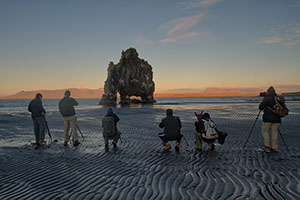 The first stop of the night was the iconic red-roofed hilltop church surrounded by the purple lupine fields that are so abundant in the country. The class moved about these healthy lupine fields and searched for the perfect bunch of flowers to help complete this must-see location in the south.
The first stop of the night was the iconic red-roofed hilltop church surrounded by the purple lupine fields that are so abundant in the country. The class moved about these healthy lupine fields and searched for the perfect bunch of flowers to help complete this must-see location in the south.
The next stop was the black sand beaches near the pointy rock formation, Reynisdrangar, which legend says is a troll that turned to stone by the sunrise while dragging a ship ashore. The class made use of the rocks in the foreground and shot the tide as it swept in and out creating contrast with the dark sand. The sunset was shaping up nicely again and the clouds changed to some pastel oranges and pinks to help make the compositions special.
The last half of the night was spent photographing some of Iceland's big waterfalls. Possibly the most photographed waterfall in the country is Skogafoss, and it was our first stop. This white curtain waterfall has been photographed about every way imaginable, but the class still enjoyed shooting from the base, or climbing the large staircase and then crawling out onto the ledge looking down on the falls and using the lush green moss and foliage to frame the shot.
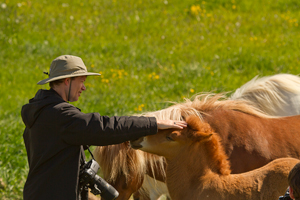 Only a short distance from Skogafoss is another, beautiful waterfall that is photographed very seldom, but in the opinions of our class, was equally as beautiful. Kvernufoss is a waterfall that, if in any other country, would warrant its own signs or trailhead. Heck, it's so big in some places it might get its own park...but here next to Skogafoss it's nothing more than a footnote most people pass on their drive out. Our class hiked to it and then worked it over with our cameras in a way that would make any waterfall photographer proud. We climbed high, we got in the water, and in the end we gave this little brother of Skogafoss the attention it deserved.
Only a short distance from Skogafoss is another, beautiful waterfall that is photographed very seldom, but in the opinions of our class, was equally as beautiful. Kvernufoss is a waterfall that, if in any other country, would warrant its own signs or trailhead. Heck, it's so big in some places it might get its own park...but here next to Skogafoss it's nothing more than a footnote most people pass on their drive out. Our class hiked to it and then worked it over with our cameras in a way that would make any waterfall photographer proud. We climbed high, we got in the water, and in the end we gave this little brother of Skogafoss the attention it deserved.
The final waterfall for the night was the also popular Seljalandsfoss. A waterfall that pours over a cliff and leaves a small cave behind it that photographers get in and shoot out from behind the waterfall. This particular night the mist was too intense for that traditional shot, so we opted for the higher angles that showcased the waterfall and the vast alluvial landscape that stretched out around it.
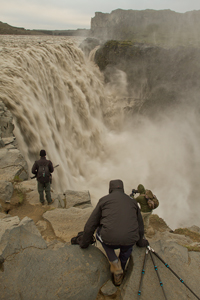 We returned to the hotel around 4:30 am after another long and productive day of photographing. Memory cards were filled and batteries were drained.
We returned to the hotel around 4:30 am after another long and productive day of photographing. Memory cards were filled and batteries were drained.
Nights three and four saw us another two hours down the road at the base of Skaftafell National Park. In addition to some time spent hiking in the park itself, the real goal for the next two nights of shooting was the nearby Jokulsarlon, a lagoon filled with the blue chunks of ice from a calving glacier. These chunks of ice bob around the lagoon and make for spectacular photography. Brian helped the class with the different settings needed to make sure they got the best possible images. In particular, since the ice is always moving it means bumping up ISO and getting faster shutter speeds to avoid having ice move during your spectacular shots.
The ice that floats around the lagoon eventually gets swept out a channel that connects the lagoon with the nearby sea. The ice gets washed up on the black sand beach, creating another totally unique type of photography experience. When the class had completed a stunning lightshow at the lagoon, we moved to the beach where the students picked out their favorite piece of ice and made artistic shots of the water moving around the cool blue chunks. This place is so special that it spawned a few of the students to lose their shoes, or just get in the water to get that close up shot of the waves and ice. All in all, we spent over five hours at the lagoon and beach making the most of an awesome set of conditions. By the end, everyone was happy, and tired. Feet were cold, batteries drained, but all cards were filled with hundreds of images that needed sorting.
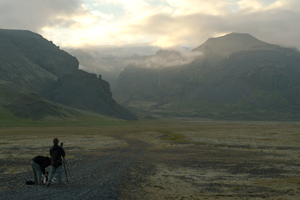 The next day started with some needed rest, followed by a demonstration on post-processing from Brian before heading back out into the lagoon for another try. The light the second night was better than the first, and the class scrambled high and low to capture the God-rays as they lit up the glacier, and cast their warm hues on the blue ice floating in the calm lagoon. It was stunning, and the class came away with truly remarkable images of blues and gold.
The next day started with some needed rest, followed by a demonstration on post-processing from Brian before heading back out into the lagoon for another try. The light the second night was better than the first, and the class scrambled high and low to capture the God-rays as they lit up the glacier, and cast their warm hues on the blue ice floating in the calm lagoon. It was stunning, and the class came away with truly remarkable images of blues and gold.
When the light had faded, we headed off to a different nearby lagoon Brian new about. This lagoon was calmer and filled with ice that was much closer to the shore. The color had faded from the sky, but the area still provided opportunities for some unique close perspectives of the glacier tongue and ice formations in the lake. It also gave the group a chance to bond over a thrilling game of "rocky-icy," a game where the goal is to throw rocks into a hole on a select piece of ice. The game was competitive and hard fought, and in the end, it was the glacial experiences of Brian Rueb that won out.
 On the way back to the hotel the class stopped at a waterfall we had seen from the road. This "little" 40 ft. waterfall had some unique perspectives using the lupine in the area as a foreground. The group scattered in the hills and each found a spot of lupine that best helped balance the composition. The class really liked this waterfall for its uniqueness and for the fact it was not something seen regularly in images from this country. Brian worked with the class on using two exposures to help achieve a better exposure. One focused on the flowers at a higher ISO and shutter speed to help stop the motion of the flowers, and the other focused and lower ISO on the background...so when the two are blended in post-processing there is an image with sharpness throughout.
On the way back to the hotel the class stopped at a waterfall we had seen from the road. This "little" 40 ft. waterfall had some unique perspectives using the lupine in the area as a foreground. The group scattered in the hills and each found a spot of lupine that best helped balance the composition. The class really liked this waterfall for its uniqueness and for the fact it was not something seen regularly in images from this country. Brian worked with the class on using two exposures to help achieve a better exposure. One focused on the flowers at a higher ISO and shutter speed to help stop the motion of the flowers, and the other focused and lower ISO on the background...so when the two are blended in post-processing there is an image with sharpness throughout.
Another long night saw us return near 5 am...our 3rd straight night of coming home late. Eat. Sleep. Shoot. Repeat!
The following day was our long driving day. We went from the south of Iceland to the north and the tiny town of Husavik, a town built on the killing of whales, but now sustained by the eco-tourism side of whaling and taking visitors out to see whales that feed in the bay.
 Along the way we made a stop at an old abandoned farmstead where we found a group of friendly, albeit sometimes TOO friendly, Icelandic horses. These horses are a unique breed...not only do they possess a special fifth gate (a fast trot) unique to them, but they are also exclusive to Iceland. No other horses are allowed in the country. Ever. Once an Icelandic pony has left Iceland, it will never be allowed to return, to ensure breed purity. These horses are bred to be friendly, confident and extremely durable for the harsh climate and landscape. In addition to those strong qualities, one unplanned side effect is that they are extremely photogenic, too. They often have long manes of contrasting colors that make them look like the rock-stars of the horse world. The class really enjoyed the scene with the old stone building, the dramatic storm lighting, and these rock-star horses.
Along the way we made a stop at an old abandoned farmstead where we found a group of friendly, albeit sometimes TOO friendly, Icelandic horses. These horses are a unique breed...not only do they possess a special fifth gate (a fast trot) unique to them, but they are also exclusive to Iceland. No other horses are allowed in the country. Ever. Once an Icelandic pony has left Iceland, it will never be allowed to return, to ensure breed purity. These horses are bred to be friendly, confident and extremely durable for the harsh climate and landscape. In addition to those strong qualities, one unplanned side effect is that they are extremely photogenic, too. They often have long manes of contrasting colors that make them look like the rock-stars of the horse world. The class really enjoyed the scene with the old stone building, the dramatic storm lighting, and these rock-star horses.
With a stop for dinner and shooting some passing waterfalls, we finally arrived in Husavik in time for a brief rest before again setting out on a night of shooting. Tonight's goal was to see Europe's largest waterfall and grab images of it and its neighbor.
 Dettifoss is the largest waterfall in Europe, and seeing it close up cements that fact instantly. About 50 yards wide, an entire angry river spills over a basalt shelf in to a chasm below. Just the mist from this powerful fall creates many tiny waterfalls on the opposite side of the canyon. The roar of the falls makes it hard to even communicate. Our class moved right to the edge of the chasm and used the leading lines and curves from the stone walls to help make creative and powerful compositions that really showcased how massive and powerful this waterfall is.
Dettifoss is the largest waterfall in Europe, and seeing it close up cements that fact instantly. About 50 yards wide, an entire angry river spills over a basalt shelf in to a chasm below. Just the mist from this powerful fall creates many tiny waterfalls on the opposite side of the canyon. The roar of the falls makes it hard to even communicate. Our class moved right to the edge of the chasm and used the leading lines and curves from the stone walls to help make creative and powerful compositions that really showcased how massive and powerful this waterfall is.
Just upriver from Dettifoss is Selfoss, a completely different and very interesting waterfall. Selfoss is a combination of nearly thirty different streams pouring over a stone shelf over the course of 100 yards. Shooting from the opposite side, it's possible to use the rocks and small pools of water that form in indentations on the rocks to make for some unique and interesting foreground elements. Even though the sky never lit up with color this night, there was some very interesting definition in the sky. Since the color of this water is almost brown from all the glacial silt, these waterfalls really lend themselves best for monochromatic shots.
We were close, so we tried to make a stop on our way back to the hotel at the Godafoss, a horseshoe-shaped waterfall that flows into a cool icy blue stream. Truly a location that makes photographers say, "Is that color REAL?" when they see the images...
 Godafoss was on its defense on this night and the mist from the falls was blowing in the wrong direction making getting any shots from the base of the fall nearly impossible. Given this was a "bonus" attempt and we still had a couple more days in the vicinity, we chalked it up to experience and went back to the hotel to get some sleep before moving from Husavik an hour south to the tiny town of Laugar, where we would again visit Godafoss, as well as another great waterfall and the local lake and interesting nearby geothermal areas.
Godafoss was on its defense on this night and the mist from the falls was blowing in the wrong direction making getting any shots from the base of the fall nearly impossible. Given this was a "bonus" attempt and we still had a couple more days in the vicinity, we chalked it up to experience and went back to the hotel to get some sleep before moving from Husavik an hour south to the tiny town of Laugar, where we would again visit Godafoss, as well as another great waterfall and the local lake and interesting nearby geothermal areas.
The second night in the area our luck improved and we were treated to no wind and lovely light at Godafoss. Golden clouds and perfection would be the best way to sum up this shot. Brian helped guide the compositions, and put people in different spots to get great images and then the class set to using polarizers and grad-filters to come away with more inspiring images from this tiny country.
The second stop of the night was located in the interior of the country, just before the roads become impassible by normal vehicles. The Aldeyjarfoss waterfall is a monster. A powerful torrent of water flows from the glaciers through a barren volcanic landscape into a bowl surrounded by some of the most bizarre and colorful basalt patterns in the country.
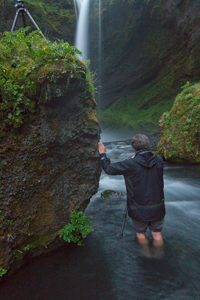 There are many vantage points for this monster. You can get up above it and look down to create shots of the falls, and the surrounding rock formations, or you can get a bit more brave and head down to a perch on the bottom left of the fall where you get to witness more of the power of the water close up, and use some of the rocks and curves to give a different foreground. Others can skirt the narrow ledges and work their way right to the base at the center of the fall, where the surge of water actually creates intense wave action that splashes over the rocks, almost as if you were by the sea.
There are many vantage points for this monster. You can get up above it and look down to create shots of the falls, and the surrounding rock formations, or you can get a bit more brave and head down to a perch on the bottom left of the fall where you get to witness more of the power of the water close up, and use some of the rocks and curves to give a different foreground. Others can skirt the narrow ledges and work their way right to the base at the center of the fall, where the surge of water actually creates intense wave action that splashes over the rocks, almost as if you were by the sea.
Brian worked with the group to compose and then use faster shutter speeds to capture the perfect movement in the water to keep the detail and contrast between the blue colored water and the white in the waves. It's hard to believe that only a few miles away this same river makes Godafoss, a waterfall that seems almost dainty by comparison.
On our way out from the dirt roads of the interior we saw light beginning to change and it was time to hit the Myvatn area. We made a brief stop to shoot some blue water and rapids with the sky turning intense pinks and reds from the rising sun. The real goal for the morning was the geothermal pools and steam vents from Namaskard, a highly geothermal area surrounding the Krafla volcano.
 The light was still intense and amazing when we arrived at the steam vents and the class quickly dispersed to find their own bubbling mud pot or hissing steam vent to use in the foreground with the mountains and sunrise in the back. Brian commented how much things had changed in the area just in the year since his last visit. New areas had formed, others had dried up...truly amazing the way nature works below the surface and creates new things for our senses.
The light was still intense and amazing when we arrived at the steam vents and the class quickly dispersed to find their own bubbling mud pot or hissing steam vent to use in the foreground with the mountains and sunrise in the back. Brian commented how much things had changed in the area just in the year since his last visit. New areas had formed, others had dried up...truly amazing the way nature works below the surface and creates new things for our senses.
There were so many good compositions here to be found that the class practically had to be drug away... which is all fine when you're shooting in the land of never ending light.
It was another return after 5 am, and most of the class opted to just stay up until breakfast and celebrate the light with a shot of patron before heading down to breakfast.
 The next night was another drive to our location, Hvitserkur. This rock has been called the dinosaur rock, because of its unique shape. It looks like a dinosaur had bent down in the bay to drink, and then was turned to stone and left there to wither in the elements. It was a bit of a drive, but the class was intrigued by the location and excited to shoot it. The best thing about this group, in addition to its hearty sense of adventure and endurance for long days, was its camaraderie. The drives to and from places were always fun and exciting as people shared funny stories, or cracked wise with one another in the car. Hopped up in Icelandic energy drinks, we made a lot of long drives and never was there a dull moment along the way. As someone commented, "it's like taking a road-trip with a bunch of buddies." That's how it felt the entire time.
The next night was another drive to our location, Hvitserkur. This rock has been called the dinosaur rock, because of its unique shape. It looks like a dinosaur had bent down in the bay to drink, and then was turned to stone and left there to wither in the elements. It was a bit of a drive, but the class was intrigued by the location and excited to shoot it. The best thing about this group, in addition to its hearty sense of adventure and endurance for long days, was its camaraderie. The drives to and from places were always fun and exciting as people shared funny stories, or cracked wise with one another in the car. Hopped up in Icelandic energy drinks, we made a lot of long drives and never was there a dull moment along the way. As someone commented, "it's like taking a road-trip with a bunch of buddies." That's how it felt the entire time.
We spent a couple hours at the dinosaur rock, shooting the lines in the black sand as the tide went out and left behind textures and patterns that were as aesthetic to see as they were to photograph. The class took a variety of great images here. Brian helped with composition review and the shooting of different exposures to deal with the bright sky and very dark rock and foreground...it was so different that not even a 4-stop grad filter would cover it all. Some photographers put on solid ND filters and took some great really long exposures of the sea moving in and out of the rock.
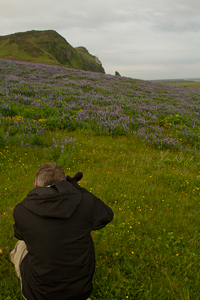 When it became clear no sunrise or sunset clouds would reach the tiny harbor, we opted to move on to shoot some spots we had found along the road when coming in. One of those spots was a tiny red boat that the class photographed using some of the mountains and colorful clouds in that section of sky. We also stopped to photograph another old abandoned farmstead that was quite photogenic, and with the sky gaining color in this area of the peninsula, we opted to shoot rather than drive.
When it became clear no sunrise or sunset clouds would reach the tiny harbor, we opted to move on to shoot some spots we had found along the road when coming in. One of those spots was a tiny red boat that the class photographed using some of the mountains and colorful clouds in that section of sky. We also stopped to photograph another old abandoned farmstead that was quite photogenic, and with the sky gaining color in this area of the peninsula, we opted to shoot rather than drive.
It was another long day, and everyone was a bit goofy from too many energy drinks and lack of sleep...at one point there was some hearty laughing and impromptu shooting of horses behaving badly that was really, REALLY hilarious, even if a bit juvenile.
We got back to the hotel, eyes glazed over from a long night and it was again only 45 minutes until breakfast, so most of the group opted to stay awake and eat before heading off to sleep before our southern bound noon departure the next day.
Along the road out, we made a stop at a location Brian knew about through a local friend, where the class was able to get up close and personal with some baby horses that were born only a month earlier. These little guys and girls were curious and quite fun to photograph. The farmer even stopped by to answer any questions on the breed or the horses the class had. It was really a neat experience, and best of all it yielded some great images.
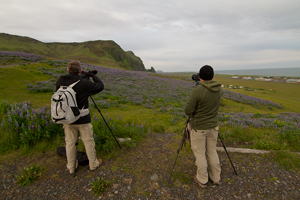 The next two nights were spent in the Western portion of the country near the Snaefellsness peninsula, home to the Snaefells glacier. With only an hour to rest up in the hotel, it was again time to head out to see the beauty of the peninsula.
The next two nights were spent in the Western portion of the country near the Snaefellsness peninsula, home to the Snaefells glacier. With only an hour to rest up in the hotel, it was again time to head out to see the beauty of the peninsula.
The first location was the mountain Krikjufell. A pointing axe blade-shaped mountain sitting alone out in a bay. We photographed it from the nearby falls aptly named, Kirkjufoss. The views from here allowed the photographers to get shots that included the falls as well as the mountain in the background. High and low, up and down the class got the best of this location and came away with some great images...and even attracted the interest of some nearby horses, which we entertained by photographing them. The horses got so close we could shoot them with our wide-angle lenses, and because they were so friendly and curious, often times we HAD to shoot them with the wide-angle lenses.
After Kirkjufell it was off on our loop around the peninsula. We made a stop to look at the parts from old shipwrecks that had washed up along a narrow cove and black sand beach. We stopped as the light from the morning began to light the clouds behind Snaefells glacier with some pinks and warm colors. Brian helped the class find some great arctic foliage with pink flowers to use as a foreground to shoot this changing morning light.
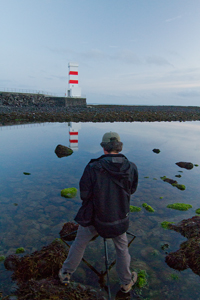 The next to final stop for the morning was the black church Budir in a tiny settlement on the peninsula's southern side. Most churches in Iceland are the traditional white church with red roof. This black wooden church with a white roof is somewhat different, and with the cool clouds behind it, was special to shoot. The class used a variety of angles and approaches to shoot the church, with the stone wall surrounding it as a leading line. Some really creative approaches used shallow depth of field and portions of the old cemetery in the foreground and the church in the back.
The next to final stop for the morning was the black church Budir in a tiny settlement on the peninsula's southern side. Most churches in Iceland are the traditional white church with red roof. This black wooden church with a white roof is somewhat different, and with the cool clouds behind it, was special to shoot. The class used a variety of angles and approaches to shoot the church, with the stone wall surrounding it as a leading line. Some really creative approaches used shallow depth of field and portions of the old cemetery in the foreground and the church in the back.
We made a last stop at the Anarstapi, a section of the coast with some spectacular basalt cliffs that butt up to the ocean. In some places these cliffs have eroded into arches and other interesting shapes that help photographers come away with some more interesting images. The color in the sky was nice, but the clouds had all moved onward. Most of the class shot from up high on the cliffs looking at the formations and the distant mountains, one student even went to the base of the cliffs to make some images. Anarstapi was beautiful and just cemented what was a long and great day of photographing beautiful light. We shot for over eight hours, and as we walked back to the van, dodging attacks from the nesting terns in the area, we knew that we would all be eating breakfast again without sleep between.
We arrived back at the hotel at 6:30 am, just in time for a celebratory shot of vodka before filling up on bacon, pastries and other breakfast goodies.
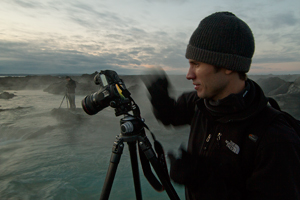 Eat. Sleep. Shoot. Repeat.
Eat. Sleep. Shoot. Repeat.
The next night we set out on an adventure to find a beautiful, but difficult to find, waterfall called Bruarfoss. Bruarfoss is not on many maps, and its location, while not terribly remote, is not easy to find...even if you know where it is and have GPS. We set out on our first dreary, storm threatened evening to find this bright blue watered falls, and come away with images.
After over an hour of driving tough, rough dirt tracks through some spectacular and wild places, we finally found the general area where the fall was located. Then it took several attempts of leaving the car and running to the river to check location before we finally found the right path that led us to this gorgeous waterfall.
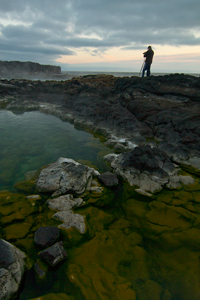 Although not as tall or powerful as many of the country's falls, this waterfall is simply stunning. The river cracks and makes two halves of waterfalls that look like they fold into one another before spilling out over some fine thin streams and into a cerulean blue channel and pool, perfectly shaped for putting as a leading line in your composition. The best spot to shoot this waterfall from was a rickety bridge over the river that allowed us to get the falls in the shot vertically or horizontally with the bright blue water and pool as our main point of interest. Even though the sky was dreary and it looked like we might get rained on, the only water we were getting on us was from the falls or that mixed with dirt in the form of the mud that was attached to everyone's footwear, gear, and in some cases, backsides.
Although not as tall or powerful as many of the country's falls, this waterfall is simply stunning. The river cracks and makes two halves of waterfalls that look like they fold into one another before spilling out over some fine thin streams and into a cerulean blue channel and pool, perfectly shaped for putting as a leading line in your composition. The best spot to shoot this waterfall from was a rickety bridge over the river that allowed us to get the falls in the shot vertically or horizontally with the bright blue water and pool as our main point of interest. Even though the sky was dreary and it looked like we might get rained on, the only water we were getting on us was from the falls or that mixed with dirt in the form of the mud that was attached to everyone's footwear, gear, and in some cases, backsides.
The dark sky really helped make the most of the water and helped it stand out even more. Once everyone had taken the high shots, many went down to the base to try and work out some different compositions, a few even got into the water with Brian to try and get closer perspectives, but by all accounts the water was FREEZING cold, and the best shots were those from the higher vantage points.
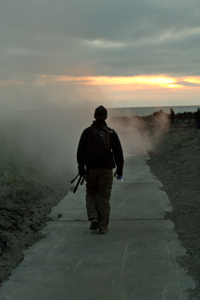 If our van wasn't dirty before setting on this night's adventure, it was certainly dirty when we returned. The dirt roads coated a layer of grime on the outside, and our dirty feet and bodies messed up the inside. It was a long road travelled to this point, and the van was testament to the travelers and over 2300 miles we'd driven thus far.
If our van wasn't dirty before setting on this night's adventure, it was certainly dirty when we returned. The dirt roads coated a layer of grime on the outside, and our dirty feet and bodies messed up the inside. It was a long road travelled to this point, and the van was testament to the travelers and over 2300 miles we'd driven thus far.
The next day was the last night for shooting and after returning to Reykjavik, and eating another wonderful fish and chips meal, we loaded up under a drizzle of rain to set off. We weren't going down without a fight. Tired but excited, we braved rain and our toughest shooting conditions of the trip to make a go at the Golden Circle, the popular day trip from the capitol, only over an hour away.
Iceland is known for its unpredictable and sometimes brutal weather. Up to this point the weather had been kind (or we had outrun it) and managed to photograph in favorable conditions nine straight nights, but here on the 10th, the rain followed us, and while we enjoyed looking at Tingvillir National Park and the spot where the North American and European tectonic plates were splitting apart, and the mighty Gulfoss, we were unable to shoot too much due to the rain. We were fortunate to have a lapse in the rain when we hit the Geysir area, and watched as the spot for which the word was named for erupted several times and allowed the class to come away with a few nice action shots of this phenomenon. With no sign of a break in the weather on the horizon, and many people facing a long travel day in the morning, we opted to head back to Reykjavik at around midnight.
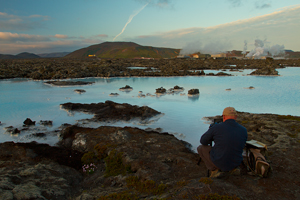 We pulled into our hotel for the last time, everyone's memory cards filled with images from a spectacular trek around Iceland. We'd seen more waterfalls than we could count, photographing many of the most iconic. We'd seen and shot the ocean in a few different spots, seen the power of the geothermal activity ever present in the country. We had befriended the local horses, and even seen a few puffins, reindeer, and fox along the way. The sheep were an ever present but humorous distraction along many of the country roads. We'd eaten and come to love the local ice cream and made daily stops to purchase and consume the dairy dessert. We had enjoyed the stories and tales of those in the car, and while some succumbed to sleep during the drives, others powered by Icelandic "Red Bull" stayed alert and kept the car alive. Our van had been dirtied and washed at least three different times during our 2400 miles of driving over the trip...and despite that, when we arrived back at the hotel on that last night, a splash of pink began to emerge from the clouds and people clambered for their cameras and set off again trying to maximize every second of light in the country with the midnight sun. Even those who weren't travelling the next day and not up for more photography were trying to figure out things they could do and shoot in the time they had left.
We pulled into our hotel for the last time, everyone's memory cards filled with images from a spectacular trek around Iceland. We'd seen more waterfalls than we could count, photographing many of the most iconic. We'd seen and shot the ocean in a few different spots, seen the power of the geothermal activity ever present in the country. We had befriended the local horses, and even seen a few puffins, reindeer, and fox along the way. The sheep were an ever present but humorous distraction along many of the country roads. We'd eaten and come to love the local ice cream and made daily stops to purchase and consume the dairy dessert. We had enjoyed the stories and tales of those in the car, and while some succumbed to sleep during the drives, others powered by Icelandic "Red Bull" stayed alert and kept the car alive. Our van had been dirtied and washed at least three different times during our 2400 miles of driving over the trip...and despite that, when we arrived back at the hotel on that last night, a splash of pink began to emerge from the clouds and people clambered for their cameras and set off again trying to maximize every second of light in the country with the midnight sun. Even those who weren't travelling the next day and not up for more photography were trying to figure out things they could do and shoot in the time they had left.
Eat. Sleep. Shoot. That was our mantra...and we held tough with it right up until the end of our adventure. Excellent job everyone, in making this Iceland Sojourn Series memorable in every way possible!
Until our next adventure,
Brian and the rest of the Aperture Academy team
If you'd like to join us at one of our workshops, you can find the schedule/sign up here.
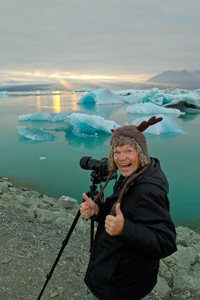 |
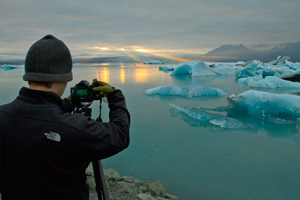 |
 |
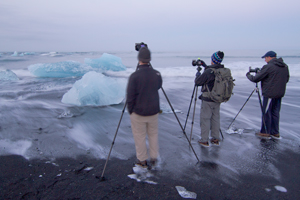 |
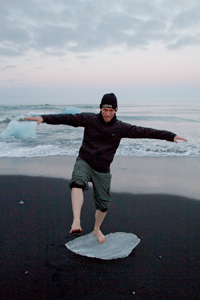 |
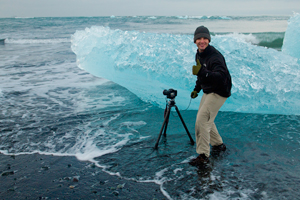 |
 |
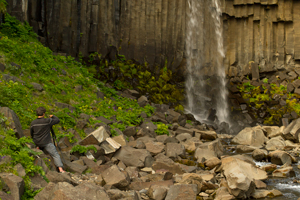 |
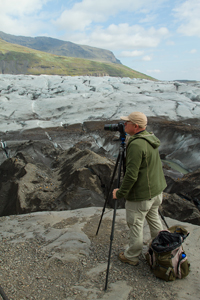 |
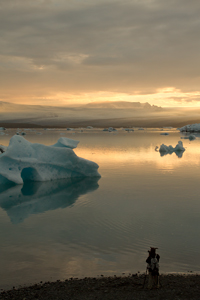 |
 |
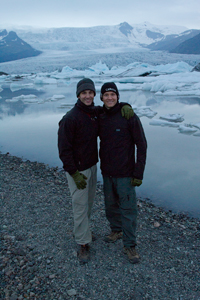 |
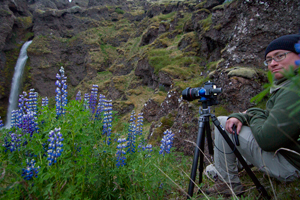 |
 |
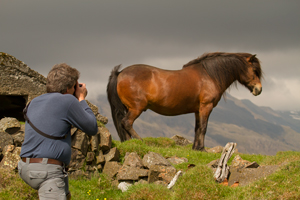 |
 |
 |
 |
 |
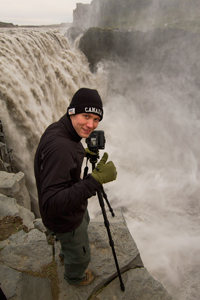 |
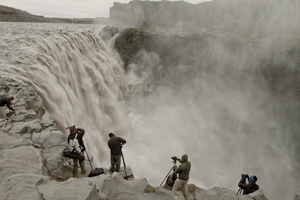 |
 |
 |
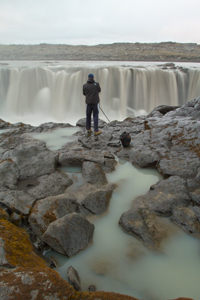 |
 |
 |
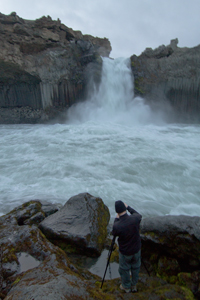 |
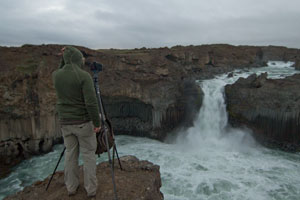 |
 |
 |
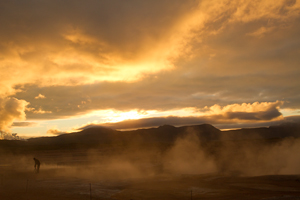 |
 |
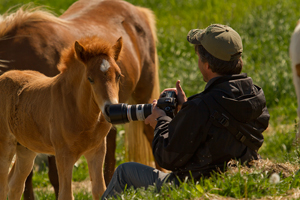 |
 |
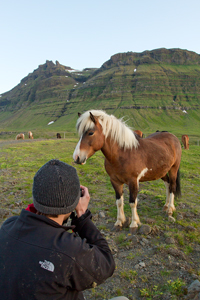 |
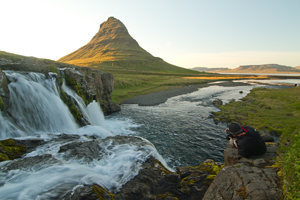 |
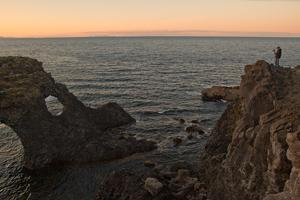 |
 |
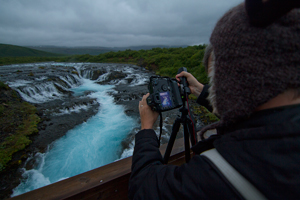 |
|
 |
Other Cool Stuff→ Past Workshop Photos → 72dpi.com → How-To Articles → Photographer of the Month |
 |
Contact Us→ Contact Us → About Us → Site Map |
© 2009-2024 Aperture Academy, Inc.







